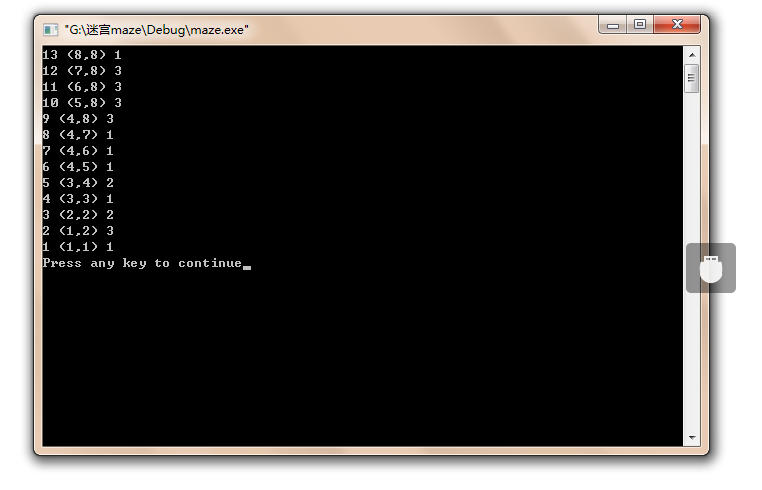1 #include <stdlib.h> 2 #include <stdio.h> 3 4 #define stackinitsize 50 5 #define stackincrement 8 6 7 typedef struct { 8 int x,y; 9 }posttype; 10 11 typedef struct { 12 int ord; 13 posttype seat; 14 int di; 15 }elemtype; 16 17 typedef struct{ 18 elemtype *base; 19 elemtype *top; 20 int stacksize; 21 }sqstack; 22 23 24 int initstack(sqstack &s) 25 {s.base=(elemtype * ) malloc(stackinitsize*sizeof(elemtype)); 26 s.top=s.base; 27 s.stacksize=stackinitsize; 28 return 1; 29 } 30 31 int push(sqstack &s,elemtype e) 32 { 33 (*(s.top)).ord=e.ord; 34 (*(s.top)).seat.x=e.seat.x; 35 (*(s.top)).seat.y=e.seat.y; 36 (*(s.top)).di=e.di; 37 s.top++; 38 return 1; 39 } 40 41 //elemtype gettop(sqstack s) 42 //{ 43 // return *(s.top-1); 44 // } 45 46 int emptystack(sqstack s) 47 {if (s.top==s.base) return 1; 48 else return 0; 49 } 50 51 int pop(sqstack &s,elemtype &e) 52 { if (emptystack(s)) return 0; 53 --s.top; 54 e.ord=(*(s.top)).ord; 55 e.seat.x=(*(s.top)).seat.x; 56 e.seat.y=(*(s.top)).seat.y; 57 e.di=(*(s.top)).di; 58 return 1; 59 }
#include <stdio.h> # include "d:mazemystack.h" #define TRUE 1 #define FALSE 0 int a[10][10]={1,1,1,1,1,1,1,1,1,1, 1,0,0,1,0,0,0,1,0,1,
1,0,0,1,0,0,0,1,0,1,
1,0,0,0,0,1,1,0,0,1,
1,0,1,1,1,0,0,0,0,1,
1,0,0,0,1,0,0,0,0,1,
1,0,1,0,0,0,1,0,0,1,
1,0,1,1,1,0,1,1,0,1,
1,1,0,0,0,0,0,0,0,1,
1,1,1,1,1,1,1,1,1,1};
typedef int Status; Status pass(posttype curpos) { if (a[curpos.x][curpos.y]==0) return 1; else return 0; } Status mazepath(int maze[10][10],posttype start,posttype end,sqstack &s) { int curstep; posttype curpos; elemtype e; initstack(s); curpos.x=start.x;curpos.y=start.y; curstep=1; do{ if(pass(curpos)) { // footprint(curpos);//stroe foot e.ord=curstep; e.seat.x=curpos.x; e.seat.y=curpos.y; e.di=1; push(s,e); if(curpos.x==end.x && curpos.y==end.y) return(TRUE); curpos.y=curpos.y+1;//east near curstep++; } else { if(!emptystack(s)) { pop(s,e); while(e.di==4 && !emptystack(s)) { // markprint(s.seat);//outprint reverse pop(s,e); }//end while if(e.di<4) { e.di++;push(s,e); switch(e.di) { case 1:curpos.y=curpos.y+1;break; case 2:curpos.x=curpos.x+1;break; case 3:curpos.y=curpos.y-1;break; case 4:curpos.x=curpos.x-1;break; } }//if(di<4) }//if(!emptystack(s)) }//else }while(!emptystack(s)); return FALSE; } void outputstak(sqstack s) { elemtype e; while(!emptystack(s)) { pop(s,e); printf("%d (%d,%d) %d ",e.ord,e.seat.x,e.seat.y,e.di); } } main() { posttype start,end; start.x=1;start.y=1; end.x=8;end.y=8; sqstack s1; if(mazepath(a,start,end,s1)==TRUE) outputstak(s1); else printf(" no path...."); }
 1
1